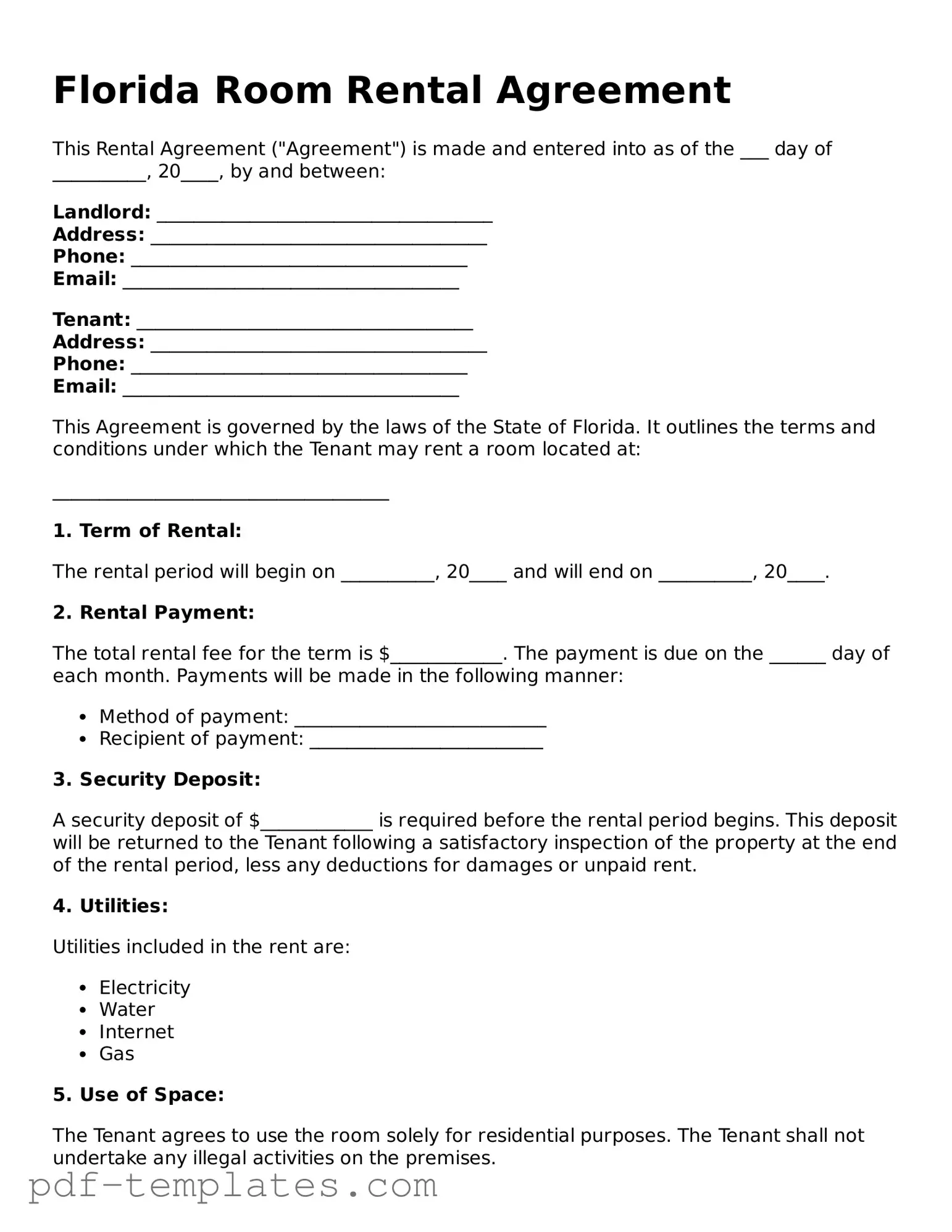The Florida Room Rental Agreement form shares similarities with a Lease Agreement. Both documents outline the terms and conditions under which a tenant can occupy a property. They typically specify the duration of the rental period, the rent amount, and the responsibilities of both the landlord and tenant. While a Room Rental Agreement may focus on renting a single room, a Lease Agreement usually pertains to an entire apartment or house. In essence, they both serve to protect the rights of both parties involved in the rental arrangement.
Another document that resembles the Florida Room Rental Agreement is the Sublease Agreement. This agreement allows a tenant to rent out their leased property to another individual, often for a portion of the original lease term. Like the Room Rental Agreement, it details the rental amount, duration, and responsibilities. The key difference lies in the fact that a sublease typically involves an existing tenant transferring their rights to another party, while the Room Rental Agreement is a direct contract between the landlord and the room renter.
The Rental Application form is also similar to the Florida Room Rental Agreement. While the Room Rental Agreement outlines the terms of rental, the Rental Application is the initial step that potential tenants must complete. This document gathers essential information about the applicant, such as employment history, rental history, and creditworthiness. Both documents work together to ensure a smooth rental process, with the application serving as a screening tool before entering into a formal agreement.
A Roommate Agreement is another document that aligns closely with the Florida Room Rental Agreement. This type of agreement is created among individuals sharing a living space. It addresses issues such as rent payments, shared responsibilities, and house rules. While the Room Rental Agreement is often between a landlord and tenant, a Roommate Agreement focuses on the relationship between individuals living together, ensuring everyone is on the same page about their living arrangements.
The California Identification Card or Senior Identification Card form, officially known as form DL 410 ID, is essential for residents seeking to apply for, renew, or replace an ID card in California. This comprehensive document not only provides detailed instructions for eligibility and the application process but also emphasizes the importance of a Social Security Number and outlines renewal by mail eligibility criteria. It serves a vital role in informing applicants about their organ donor status, veteran benefits, and voting options, ensuring they are well-prepared to fulfill all requirements. For those looking for more information, you can access All California Forms.
The Lease Addendum is also relevant. This document modifies or adds to an existing lease agreement, similar to how a Room Rental Agreement can include additional terms specific to the room being rented. For example, if a tenant wishes to add specific rules regarding shared spaces or utilities, an addendum can formally document these changes. Both documents help clarify expectations and responsibilities, ensuring all parties are informed of any alterations to the original agreement.
The Eviction Notice is another document related to the Florida Room Rental Agreement. While the Room Rental Agreement sets the terms for renting a room, an Eviction Notice is used when a landlord needs to terminate that agreement due to violations of its terms. This document outlines the reasons for eviction, such as non-payment of rent or breach of contract. Although they serve different purposes, both documents are essential in the landlord-tenant relationship and help maintain order and compliance.
The Move-In Checklist is also similar in function to the Florida Room Rental Agreement. This checklist is often used at the beginning of a rental period to document the condition of the room and any furnishings included. It helps protect both the landlord and tenant by providing a record of the property's state before the tenant moves in. While the Room Rental Agreement establishes the legal relationship, the Move-In Checklist serves as a practical tool for ensuring transparency and accountability.
Lastly, the Security Deposit Agreement often accompanies the Florida Room Rental Agreement. This document outlines the terms under which a security deposit is collected, held, and returned. It details the amount of the deposit, the conditions for its return, and any deductions that may be made for damages. Both agreements are crucial in protecting the interests of the landlord while providing the tenant with a clear understanding of their financial obligations.
